Correlation of Materials Property and Performance with Internal Structures Evolvement Revealed by Laboratory X-ray Tomography
Abstract
1. Introduction
1.1. XRT and In Situ Experiment
1.2. Laboratory-Based and Synchrotron Radiation XRT
1.3. Timing for XRT
1.4. Effective Factors of LB-XRT
1.5. Studied Cases with In Situ XRT
2. Experimental Method
3. LB-XRT Examples
3.1. Mechanical Loading
3.2. Heat Treatment
3.3. Electropulsing Treatment
3.4. Protective Coating from Corrosion
3.5. Electrochemical Reaction
3.6. Nano XRT In Situ Experiment
4. Conclusions and Perspective
Acknowledgments
Conflicts of Interest
References
- Withers, P.J.; Preuss, M. Fatigue and damage in structural materials studied by X-ray tomography. Annu. Rev. Mater. Res. 2012, 42, 81–103. [Google Scholar] [CrossRef]
- Zankel, A.; Wagner, J.; Poelt, P. Serial sectioning methods for 3D investigations in materials science. Micron 2014, 62, 66–78. [Google Scholar] [CrossRef] [PubMed]
- Burnett, T.L.; Kelley, R.; Winiarski, B.; Contreras, L.; Daly, M.; Gholinia, A.; Burke, M.G.; Withers, P.J. Large volume serial section tomography by Xe plasma FIB dual beam microscopy. Ultramicroscopy 2016, 161, 119–129. [Google Scholar] [CrossRef] [PubMed]
- Gault, B. Atom probe microscopy. In Springer Series in Materials Science; Springer: New York, NY, USA, 2012; p. 396. [Google Scholar]
- Cerezo, A.; Clifton, P.H.; Lozano-Perez, S.; Panayi, P.; Sha, G.; Smith, G.D.W. Overview: Recent progress in three-dimensional atom probe instruments and applications. Microsc. Microanal. 2007, 13, 408–417. [Google Scholar] [CrossRef] [PubMed]
- Blavette, D.; Cadel, E.; Pareige, C.; Deconihout, B.; Caron, P. Phase transformation and segregation to lattice defects in Ni-base superalloys. Microsc. Microanal. 2007, 13, 464–483. [Google Scholar] [CrossRef] [PubMed]
- Saghi, Z.; Midgley, P.A. Electron tomography in the (S)TEM: From nanoscale morphological analysis to 3D atomic imaging. Annu. Rev. Mater. Res. 2012, 42, 59–79. [Google Scholar] [CrossRef]
- Midgley, P.A.; Weyland, M. 3D electron microscopy in the physical sciences: The development of Z-contrast and EFTEM tomography. Ultramicroscopy 2003, 96, 413–431. [Google Scholar] [CrossRef]
- Stock, S.R. X-ray microtomography of materials. Int. Mater. Rev. 1999, 44, 141–164. [Google Scholar] [CrossRef]
- Stock, S.R. Recent advances in X-ray microtomography applied to materials. Int. Mater. Rev. 2008, 53, 129–181. [Google Scholar] [CrossRef]
- Atturan, U.A.; Nandam, S.H.; Murty, B.S.; Sankaran, S. Deformation behaviour of in-situ TiB2 reinforced A357 aluminium alloy composite foams under compressive and impact loading. Mater. Sci. Eng. A 2017, 684, 178–185. [Google Scholar] [CrossRef]
- Ferre, A.; Dancette, S.; Maire, E. Damage characterisation in aluminium matrix composites reinforced with amorphous metal inclusions. Mater. Sci. Technol. Lond. 2015, 31, 579–586. [Google Scholar] [CrossRef]
- Nikishkov, Y.; Seon, G.; Makeev, A.; Shonkwiler, B. In-situ measurements of fracture toughness properties in composite laminates. Mater. Des. 2016, 94, 303–313. [Google Scholar] [CrossRef]
- Dillard, T.; Guyen, F.; Maire, E.; Salvo, L.; Forest, S.; Bienvenu, Y.; Bartout, J.D.; Croset, M.; Dendievel, R.; Cloetens, P. 3D quantitative image analysis of open-cell nickel foams under tension and compression loading using X-ray microtomography. Philos. Mag. 2005, 85, 2147–2175. [Google Scholar] [CrossRef]
- Maire, E. X-ray tomography applied to the characterization of highly porous materials. Annu. Rev. Mater. Res. 2012, 42, 163–178. [Google Scholar] [CrossRef]
- Petit, C.; Meille, S.; Maire, E. Cellular solids studied by X-ray tomography and finite element modeling—A review. J. Mater. Res. 2013, 28, 2191–2201. [Google Scholar] [CrossRef]
- Hornberger, B.; Bale, H.; Merkle, A.; Feser, M.; Harris, W.; Etchin, S.; Leibowitz, M.; Qiu, W.; Tkachuk, A.; Gu, A.; et al. X-ray microscopy for in situ characterization of 3D nanostructural evolution in the laboratory. In X-ray Nanoimaging: Instruments and Methods II; SPIE: Bellingham WA, USA, 2015; Volume 9592. [Google Scholar]
- Fratini, M.; Campi, G.; Bukreeva, I.; Pelliccia, D.; Burghammer, M.; Tromba, G.; Cancedda, R.; Mastrogiacomo, M.; Cedola, A. X-ray micro-beam techniques and phase contrast tomography applied to biomaterials. Nucl. Instrum. Methods B 2015, 364, 93–97. [Google Scholar] [CrossRef]
- Bradley, R.S.; Withers, P.J. Correlative multiscale tomography of biological materials. Mrs Bull. 2016, 41, 549–554. [Google Scholar] [CrossRef]
- Maire, E.; Withers, P.J. Quantitative X-ray tomography. Int. Mater. Rev. 2014, 59, 1–43. [Google Scholar] [CrossRef]
- Ludwig, W.; King, A.; Herbig, M.; Reischig, P.; Marrow, J.; Babout, L.; Lauridsen, E.M.; Proudhon, H.; Buffiere, J.Y. Characterization of polycrystalline materials using synchrotron X-ray imaging and diffraction techniques. JOM 2010, 62, 22–28. [Google Scholar] [CrossRef]
- Ludwig, W.; Schmidt, S.; Lauridsen, E.M.; Poulsen, H.F. X-ray diffraction contrast tomography: A novel technique for three-dimensional grain mapping of polycrystals. I. Direct beam case. J. Appl. Crystallogr. 2008, 41, 302–309. [Google Scholar] [CrossRef]
- Poulsen, H.F. An introduction to three-dimensional X-ray diffraction microscopy. J. Appl. Crystallogr. 2012, 45, 1084–1097. [Google Scholar] [CrossRef]
- Poulsen, H.F.; Jensen, D.J.; Vaughan, G.B.M. Three-dimensional X-ray diffraction microscopy using high-energy X-rays. MRS Bull. 2004, 29, 166–169. [Google Scholar] [CrossRef]
- Requena, G.; Degischer, H.P. Three-dimensional architecture of engineering multiphase metals. Annu. Rev. Mater. Res. 2012, 42, 145–161. [Google Scholar] [CrossRef]
- Toda, H.; Maire, E.; Aoki, Y.; Kobayashi, M. Three-dimensional strain mapping using in situ X-ray synchrotron microtomography. J. Strain. Anal. Eng. 2011, 46, 549–561. [Google Scholar] [CrossRef]
- Guvenilir, A.; Breunig, T.M.; Kinney, J.H.; Stock, S.R. Direct observation of crack opening as a function of applied load in the interior of a notched tensile sample of Al-Li 2090. Acta Mater. 1997, 45, 1977–1987. [Google Scholar] [CrossRef]
- Babout, L.; Maire, E.; Fougeres, R. Damage initiation in model metallic materials: X-ray tomography and modelling. Acta Mater. 2004, 52, 2475–2487. [Google Scholar] [CrossRef]
- Hannard, F.; Pardoen, T.; Maire, E.; Le Bourlot, C.; Mokso, R.; Simar, A. Characterization and micromechanical modelling of microstructural heterogeneity effects on ductile fracture of 6xxx aluminium alloys. Acta Mater. 2016, 103, 558–572. [Google Scholar] [CrossRef]
- Maire, E.; Zhou, S.X.; Adrien, J.; Dimichiel, M. Damage quantification in aluminium alloys using in situ tensile tests in X-ray tomography. Eng. Fract. Mech. 2011, 78, 2679–2690. [Google Scholar] [CrossRef]
- Patterson, B.M.; Cordes, N.L.; Henderson, K.; Mertens, J.C.E.; Clarke, A.J.; Hornberger, B.; Merkle, A.; Etchin, S.; Tkachuk, A.; Leibowitz, M.; et al. In situ laboratory-based transmission X-ray microscopy and tomography of material deformation at the nanoscale. Exp. Mech. 2016, 56, 1585–1597. [Google Scholar] [CrossRef]
- Pottmeyer, F.; Bittner, J.; Pinter, P.; Weidenmann, K.A. In-situ CT damage analysis of metal inserts embedded in carbon fiber-reinforced plastics. Exp. Mech. 2017, 57, 1411–1422. [Google Scholar] [CrossRef]
- Revil-Baudard, B.; Cazacu, O.; Flater, P.; Chandola, N.; Alves, J.L. Unusual plastic deformation and damage features in titanium: Experimental tests and constitutive modeling. J. Mech. Phys. Solids 2016, 88, 100–122. [Google Scholar] [CrossRef]
- Marrow, J.; Reinhard, C.; Vertyagina, Y.; Saucedo-Mora, L.; Collins, D.; Mostafavi, M. 3D studies of damage by combined X-ray tomography and digital volume correlation. Proc. Mater. Sci. 2014, 3, 1554–1559. [Google Scholar] [CrossRef]
- Mostafavi, M.; Collins, D.M.; Cai, B.; Bradley, R.; Atwood, R.C.; Reinhard, C.; Jiang, X.; Galano, M.; Lee, P.D.; Marrow, T.J. Yield behavior beneath hardness indentations in ductile metals, measured by three-dimensional computed X-ray tomography and digital volume correlation. Acta Mater. 2015, 82, 468–482. [Google Scholar] [CrossRef]
- Mostafavi, M.; Vertyagina, Y.; Reinhard, C.; Bradley, R.; Jiang, X.; Galano, M.; Marrow, J. 3D studies of indentation by combined X-ray tomography and digital volume correlation. Key Eng. Mater. 2014, 3, 592–593. [Google Scholar] [CrossRef]
- Girault, B.; Vidal, V.; Thilly, L.; Renault, P.O.; Goudeau, P.; Le Bourhis, E.; Villain-Valat, P.; Geandier, G.; Tranchant, J.; Landesman, J.P.; et al. Small scale mechanical properties of polycrystalline materials: In situ diffraction studies. Int. J. Nanotechnol. 2008, 5, 609–630. [Google Scholar] [CrossRef]
- Salvo, L.; Belestin, P.; Maire, E.; Jacquesson, M.; Vecchionacci, C.; Boller, E.; Bornert, M.; Doumalin, P. Structure and mechanical properties of AFS sandwiches studied by in-situ compression tests in X-ray microtomography. Adv. Eng. Mater. 2004, 6, 411–415. [Google Scholar] [CrossRef]
- Lin, J.L.; Mo, K.; Yun, D.; Miao, Y.B.; Liu, X.; Zhao, H.J.; Hoelzer, D.T.; Park, J.S.; Almer, J.; Zhang, G.M.; et al. In situ synchrotron tensile investigations on 14YWT, MA957, and 9-Cr ODS alloys. J. Nucl. Mater. 2016, 471, 289–298. [Google Scholar] [CrossRef]
- Phillion, A.B.; Cockcroft, S.L.; Lee, P.D. A new methodology for measurement of semi-solid constitutive behavior and its application to examination of as-cast porosity and hot tearing in aluminum alloys. Mater. Sci. Eng. A 2008, 491, 237–247. [Google Scholar] [CrossRef]
- Gan, Y.Y.; Mo, K.; Yun, D.; Hoelzer, D.T.; Miao, Y.B.; Liu, X.; Lan, K.C.; Park, J.S.; Almer, J.; Chen, T.Y.; et al. Temperature effect of elastic anisotropy and internal strain development in advanced nanostructured alloys: An in-situ synchrotron X-ray investigation. Mater. Sci. Eng. A 2017, 692, 53–61. [Google Scholar] [CrossRef]
- Wang, S.G.; Sun, M.Y.; Song, Z.Q.; Xu, J. Cast defects induced sample-size dependency on compressive strength and fracture toughness of Mg-Cu-Ag-Gd bulk metallic glass. Intermetallics 2012, 29, 123–132. [Google Scholar] [CrossRef]
- Marcadon, V.; Davoine, C.; Passilly, B.; Boivin, D.; Popoff, F.; Rafray, A.; Kruch, S. Mechanical behaviour of hollow-tube stackings: Experimental characterization and modelling of the role of their constitutive material behaviour. Acta Mater. 2012, 60, 5626–5644. [Google Scholar] [CrossRef]
- Siegkas, P.; Tagarielli, V.; Petrinic, N.; Lefebvre, L.P. Rate dependency of the response of Ti foams in compression. Material 2012, 2, 661–666. [Google Scholar]
- Patterson, B.M.; Henderson, K.; Gilbertson, R.D.; Tornga, S.; Cordes, N.L.; Chavez, M.E.; Smith, Z. Morphological and performance measures of polyurethane foams using X-ray CT and mechanical testing. Microsc. Microanal. 2014, 20, 1284–1293. [Google Scholar] [CrossRef] [PubMed]
- Ou, X.X.; Zhang, X.; Lowe, T.; Blanc, R.; Rad, M.N.; Wang, Y.; Batail, N.; Pham, C.; Shokri, N.; Garforth, A.A.; et al. X-ray micro computed tomography characterization of cellular SiC foams for their applications in chemical engineering. Mater. Charact. 2017, 123, 20–28. [Google Scholar] [CrossRef]
- Hu, X.F.; Wang, L.B.; Xu, F.; Xiao, T.Q.; Zhang, Z. In situ observations of fractures in short carbon fiber/epoxy composites. Carbon 2014, 67, 368–376. [Google Scholar] [CrossRef]
- Bayraktar, E.; Bessri, K.; Bathias, C. Deformation behaviour of elastomeric matrix composites under static loading conditions. Eng. Fract. Mech. 2008, 75, 2695–2706. [Google Scholar] [CrossRef]
- Patterson, B.M.; Cordes, N.L.; Henderson, K.; Williams, J.J.; Stannard, T.; Singh, S.S.; Ovejero, A.R.; Xiao, X.H.; Robinson, M.; Chawla, N. In situ X-ray synchrotron tomographic imaging during the compression of hyper-elastic polymeric materials. J. Mater. Sci. 2016, 51, 171–187. [Google Scholar] [CrossRef]
- Tourret, D.; Mertens, J.C.E.; Lieberman, E.; Imhoff, S.D.; Gibbs, J.W.; Henderson, K.; Fezzaa, K.; Deriy, A.L.; Sun, T.; Lebensohn, R.A.; et al. From solidification processing to microstructure to mechanical properties: A multi-scale X-ray study of an Al-Cu alloy sample. Metall. Mater. Trans. A 2017, 48A, 5529–5546. [Google Scholar] [CrossRef]
- Daudin, R.; Terzi, S.; Lhuissier, P.; Salvo, L.; Boller, E. Remelting and solidification of a 6082 Al alloy containing submicron yttria particles: 4D experimental study by in situ X-ray microtomography. Mater. Des. 2015, 87, 313–317. [Google Scholar] [CrossRef]
- Daudin, R.; Terzi, S.; Lhuissier, P.; Tamayo, J.; Scheel, M.; Babu, N.H.; Eskin, D.G.; Salvo, L. Particle-induced morphological modification of Al alloy equiaxed dendrites revealed by sub-second in situ microtomography. Acta Mater. 2017, 125, 303–310. [Google Scholar] [CrossRef]
- Schleef, S.; Lowe, H.; Schneebeli, M. Hot-pressure sintering of low-density snow analyzed by X-ray microtomography and in situ microcompression. Acta Mater. 2014, 71, 185–194. [Google Scholar] [CrossRef]
- Wu, Z.; Sun, L.C.; Wang, J.Y. Effects of sintering method and sintering temperature on the microstructure and properties of porous Y2SiO5. J. Mater. Sci. Technol. 2015, 31, 1237–1243. [Google Scholar] [CrossRef]
- Cai, B.; Wang, J.; Kao, A.; Pericleous, K.; Phillion, A.B.; Atwood, R.C.; Lee, P.D. 4D synchrotron X-ray tomographic quantification of the transition from cellular to dendrite growth during directional solidification. Acta Mater. 2016, 117, 160–169. [Google Scholar] [CrossRef]
- Alvarez-Murga, M.; Perrillat, J.P.; Le Godec, Y.; Bergame, F.; Philippe, J.; King, A.; Guignot, N.; Mezouar, M.; Hodeau, J.L. Development of synchrotron X-ray micro-tomography under extreme conditions of pressure and temperature. J. Synchrotron Radiat. 2017, 24, 240–247. [Google Scholar] [CrossRef] [PubMed]
- Liu, D.; Gludovatz, B.; Barnard, H.S.; Kuball, M.; Ritchie, R.O. Damage tolerance of nuclear graphite at elevated temperatures. Nat. Commun. 2017, 8, 15942. [Google Scholar] [CrossRef] [PubMed]
- Galli, S.; Hammel, J.U.; Herzen, J.; Damm, T.; Jimbo, R.; Beckmann, F.; Wennerberg, A.; Willumeit-Romer, R. Evaluation of the degradation behavior of resorbable metal implants for in vivo osteosynthesis by synchrotron radiation based X-ray tomography and histology. Proc. SPIE 2016, 9967, 996704. [Google Scholar]
- Singh, S.S.; Stannard, T.J.; Xiao, X.H.; Chawla, N. In situ X-ray microtomography of stress corrosion cracking and corrosion fatigue in aluminum alloys. JOM 2017, 69, 1404–1414. [Google Scholar] [CrossRef]
- Wang, S.G.; Wang, S.C.; Zhang, L. Application of high resolution transmission X-ray tomography in material science. Acta Metall. Sin. 2013, 49, 897–910. [Google Scholar] [CrossRef]
- Brushett, F.R.; Trahey, L.; Xiao, X.H.; Vaughey, J.T. Full-field synchrotron tomography of nongraphitic foam and laminate anodes for lithium-ion batteries. ACS Appl. Mater. Int. 2014, 6, 4524–4534. [Google Scholar] [CrossRef] [PubMed]
- Drozhzhin, O.A.; Sumanov, V.D.; Karakulina, O.M.; Abakumov, A.M.; Hadermann, J.; Baranov, A.N.; Stevenson, K.J.; Antipov, E.V. Switching between solid solution and two-phase regimes in the Li1-xFe1-yMnyPO4 cathode materials during lithium (de)insertion: Combined pitt, in situ XRPD and electron diffraction tomography study. Electrochim. Acta 2016, 191, 149–157. [Google Scholar] [CrossRef]
- Harris, S.J.; Lu, P. Effects of inhomogeneities-nanoscale to mesoscale-on the durability of Li-ion batteries. J. Phys. Chem. C 2013, 117, 6481–6492. [Google Scholar] [CrossRef]
- Michailidis, N. Strain rate dependent compression response of Ni-foam investigated by experimental and FEM simulation methods. Mater. Sci. Eng. A 2011, 528, 4204–4208. [Google Scholar] [CrossRef]
- Michailidis, N.; Stergioudi, F.; Omar, H.; Papadopoulos, D.; Tsipas, D.N. Experimental and FEM analysis of the material response of porous metals imposed to mechanical loading. Colloid Surf. A 2011, 382, 124–131. [Google Scholar] [CrossRef]
- Petit, C.; Maire, E.; Meille, S.; Adrien, J. Two-scale study of the fracture of an aluminum foam by X-ray tomography and finite element modeling. Mater. Des. 2017, 120, 117–127. [Google Scholar] [CrossRef]
- Buffiere, J.Y.; Maire, E.; Adrien, J.; Masse, J.P.; Boller, E. In situ experiments with X-ray tomography: An attractive tool for experimental mechanics. Exp. Mech. 2010, 50, 289–305. [Google Scholar] [CrossRef]
- Mayo, S.C.; Miller, P.R.; Wilkins, S.W.; Davis, T.J.; Gao, D.; Gureyev, T.E.; Paganin, D.; Parry, D.J.; Pogany, A.; Stevenson, A.W. Quantitative X-ray projection microscopy: Phase-contrast and multi-spectral imaging. J. Microsc. 2002, 207, 79–96. [Google Scholar] [CrossRef] [PubMed]
- Wang, S.; Lau, S.H.; Tkachuk, A.; Druewer, F.; Chang, H.; Feser, M.; Yun, W.B. Non-destructive 3D imaging of nano-structures with multi-scale X-ray microscopy. NSTI Nanotech. 2008, 1, 822–825. [Google Scholar]
- Als-Nielsen, J.; McMorrow, D. Elements of Modern X-ray Physics; Wiley: New York, NY, USA; Chichester, UK, 2001. [Google Scholar]
- Villanova, J.; Daudin, R.; Lhuissier, P.; Jauffres, D.; Lou, S.Y.; Martin, C.L.; Laboure, S.; Tucoulou, R.; Martinez-Criado, G.; Salvo, L. Fast in situ 3D nanoimaging: A new tool for dynamic characterization in materials science. Mater. Today 2017, 20, 354–359. [Google Scholar] [CrossRef]
- Lee, S.; Kwon, I.H.; Kim, J.Y.; Yang, S.S.; Kang, S.; Lim, J. Early commissioning results for spectroscopic X-ray nano-imaging beamline BL 7C SXNI at PLS-II. J. Synchrotron Radiat. 2017, 24, 1276–1282. [Google Scholar] [CrossRef] [PubMed]
- Baruchel, J. X-ray Tomography in Material Science; Hermes Science: Paris, France, 2000; p. 204. [Google Scholar]
- Vedula, V.S.V.M.; Munshi, P. An improved algorithm for beam-hardening corrections in experimental X-ray tomography. Ndt&E Int. 2008, 41, 25–31. [Google Scholar]
- Rau, C.; Somogyi, A.; Simionovici, A. Microimaging and tomography with chemical speciation. Nucl. Instrum. Meth. B 2003, 200, 444–450. [Google Scholar] [CrossRef]
- Meirer, F.; Cabana, J.; Liu, Y.J.; Mehta, A.; Andrews, J.C.; Pianetta, P. Three-dimensional imaging of chemical phase transformations at the nanoscale with full-field transmission X-ray microscopy. J. Synchrotron Radiat. 2011, 18, 773–781. [Google Scholar] [CrossRef] [PubMed]
- Arhatari, B.D.; Gureyev, T.E.; Abbey, B. Elemental contrast X-ray tomography using ross filter pairs with a polychromatic laboratory source. Sci. Rep. UK 2017, 7, 218. [Google Scholar] [CrossRef] [PubMed]
- Fullagar, W.; Uhlig, J.; Walczak, M.; Canton, S.; Sundstrom, V. The use and characterization of a backilluminated charge-coupled device in investigations of pulsed X-ray and radiation sources. Rev. Sci. Instrum. 2008, 79, 103302. [Google Scholar] [CrossRef] [PubMed]
- Fullagar, W.K.; Paziresh, M.; Latham, S.J.; Myers, G.R.; Kingston, A.M. The index of dispersion as a metric of quanta—Unravelling the fano factor. Acta Crystallogr. B 2017, 73, 675–695. [Google Scholar] [CrossRef] [PubMed]
- Jacques, S.D.M.; Egan, C.K.; Wilson, M.D.; Veale, M.C.; Seller, P.; Cernik, R.J. A laboratory system for element specific hyperspectral X-ray imaging. Analyst 2013, 138, 755–759. [Google Scholar] [CrossRef] [PubMed]
- Egan, C.K.; Jacques, S.D.M.; Wilson, M.D.; Veale, M.C.; Seller, P.; Beale, A.M.; Pattrick, R.A.D.; Withers, P.J.; Cernik, R.J. 3D chemical imaging in the laboratory by hyperspectral X-ray computed tomography. Sci. Rep. UK 2015, 5, 15979. [Google Scholar] [CrossRef] [PubMed]
- Withers, P.J. X-ray nanotomography. Mater. Today 2007, 10, 26–34. [Google Scholar] [CrossRef]
- Wang, Y.X.; Duewer, F.; Kamath, S.; Scott, D.; Yun, W.B. A novel X-ray microtomography system with high resolution and throughput. NSTI Nanotech. 2004, 3, 503–507. [Google Scholar]
- Bleuet, P.; Laloum, D.; Audoit, G.; Torrecillas, R.; Gaillard, F.X. SEM-based system for 100nm X-ray tomography for the analysis of porous silicon. In Developments in X-ray Tomography IX; SPIE: Bellingham, WA, USA, 2014; Volume 9212, p. 92120Z. [Google Scholar]
- Perini, L.A.G.; Bleuet, P.; Filevich, J.; Parker, W.; Buijsse, B.; Kwakman, L.F.T. Developments on a SEM-based X-ray tomography system: Stabilization scheme and performance evaluation. Rev. Sci. Instrum. 2017, 88, 063706. [Google Scholar]
- Yin, G.C.; Song, Y.F.; Tang, M.T.; Chen, F.R.; Liang, K.S.; Duewer, F.W.; Feser, M.; Yun, W.B.; Shieh, H.P.D. 30 nm resolution X-ray imaging at 8 keV using third order diffraction of a zone plate lens objective in a transmission microscope. Appl. Phys. Lett. 2006, 89, 221122. [Google Scholar] [CrossRef]
- Tkachuk, A.; Duewer, F.; Cui, H.T.; Feser, M.; Wang, S.; Yun, W.B. X-ray computed tomography in zernike phase contrast mode at 8 keV with 50-nm resolution using Cu rotating anode X-ray source. Z. Kristallogr. 2007, 222, 650–655. [Google Scholar] [CrossRef]
- Harding, G.; David, B.; Schlomka, J.P. Liquid metal anode X-ray sources and their potential applications. Nucl. Instrum. Methods B 2004, 213, 189–196. [Google Scholar] [CrossRef]
- Snigireva, I.; Vaughan, G.B.M.; Snigirev, A. High-energy nanoscale-resolution X-ray microscopy based on refractive optics on a long beamline. AIP Conf. Proc. 2011, 1365, 188–191. [Google Scholar]
- Rau, C.; Crecea, V.; Richter, C.P.; Peterson, K.M.; Jemian, P.R.; Neuhausler, U.; Schneider, G.; Yu, X.; Braun, P.V.; Chiang, T.C.; et al. A hard X-ray KB-FZP microscope for tomography with sub-100-nm resolution. In Proceedings of the Developments in X-Ray Tomography V, San Diego, CA, USA, 15–17 August 2006; Volume 6318, p. 63181G. [Google Scholar]
- Matsuyama, S.; Yasuda, S.; Yamada, J.; Okada, H.; Kohmura, Y.; Yabashi, M.; Ishikawa, T.; Yamauchi, K. 50-nm-resolution full-field X-ray microscope without chromatic aberration using total-reflection imaging mirrors. Sci. Rep. UK 2017, 7, 46358. [Google Scholar] [CrossRef] [PubMed]
- Feng, B.G.; Deng, B.; Ren, Y.Q.; Wang, Y.D.; Du, G.H.; Tan, H.; Xue, Y.L.; Xiao, T.Q. Full-field X ray nano-imaging system designed and constructed at ssrf. Chin. Opt. Lett. 2016, 14, 093401. [Google Scholar] [CrossRef]
- Bradley, R.S.; Liu, Y.; Burnett, T.L.; Zhou, X.; Lyon, S.B.; Withers, P.J.; Gholinia, A.; Hashimoto, T.; Graham, D.; Gibbon, S.R.; et al. Time-lapse lab-based X-ray nano-CT study of corrosion damage. J. Microsc. Oxf. 2017, 267, 98–106. [Google Scholar] [CrossRef] [PubMed]
- Patterson, B.M.; Henderson, K.C.; Gibbs, P.J.; Imhoff, S.D.; Clarke, A.J. Laboratory micro- and nanoscale X-ray tomographic investigation of Al-7 at%Cu solidification structures. Mater. Charact. 2014, 95, 18–26. [Google Scholar] [CrossRef]
- Wu, X.Z.; Liu, H.; Yan, A. Phase-contrast X-ray tomography: Contrast mechanism and roles of phase retrieval. Eur. J. Radiol. 2008, 68, S8–S12. [Google Scholar] [CrossRef] [PubMed]
- Bronnikov, A.V. Phase-contrast CT: Fundamental theorem and fast image reconstruction algorithms. Proc. SPIE 2006, 6318, Q3180. [Google Scholar]
- McCann, M.T.; Nilchian, M.; Stampanoni, M.; Unser, M. Fast 3D reconstruction method for differential phase contrast X-ray CT. Opt. Express 2016, 24, 14564–14581. [Google Scholar] [CrossRef] [PubMed]
- Salvo, L.; Suery, M.; Marmottant, A.; Limodin, N.; Bernard, D. 3D imaging in material science: Application of X-ray tomography. C. R. Phys. 2010, 11, 641–649. [Google Scholar] [CrossRef]
- Wu, S.C.; Xiao, T.Q.; Withers, P.J. The imaging of failure in structural materials by synchrotron radiation X-ray microtomography. Eng. Fract. Mech. 2017, 182, 127–156. [Google Scholar] [CrossRef]
- Rowenhorst, D.J.; Voorhees, P.W. Measurement of interfacial evolution in three dimensions. Annu. Rev. Mater. Res. 2012, 42, 105–124. [Google Scholar] [CrossRef]
- Zhao, S.; Li, S.J.; Wang, S.G.; Hou, W.T.; Li, Y.; Zhang, L.C.; Hao, Y.L.; Yang, R.; Misra, R.D.K.; Murr, L.E. Compressive and fatigue behavior of functionally graded Ti-6Al-4V meshes fabricated by electron beam melting. Acta Mater. 2018, 150, 1–15. [Google Scholar] [CrossRef]
- Choy, S.Y.; Sun, C.N.; Leong, K.F.; Wei, J. Compressive properties of functionally graded lattice structures manufactured by selective laser melting. Mater. Des. 2017, 131, 112–120. [Google Scholar] [CrossRef]
- Limmahakhun, S.; Oloyede, A.; Sitthiseripratip, K.; Xiao, Y.; Yan, C. Stiffness and strength tailoring of cobalt chromium graded cellular structures for stress-shielding reduction. Mater. Des. 2017, 114, 633–641. [Google Scholar] [CrossRef]
- Li, S.J.; Murr, L.E.; Cheng, X.Y.; Zhang, Z.B.; Hao, Y.L.; Yang, R.; Medina, F.; Wicker, R.B. Compression fatigue behavior of Ti-6Al-4V mesh arrays fabricated by electron beam melting. Acta Mater. 2012, 60, 793–802. [Google Scholar] [CrossRef]
- Sugimura, Y.; Rabiei, A.; Evans, A.G.; Harte, A.M.; Fleck, N.A. Compression fatigue of a cellular Al alloy. Mater. Sci. Eng. A 1999, 269, 38–48. [Google Scholar] [CrossRef]
- Li, S.J.; Zhao, S.; Hou, W.T.; Teng, C.Y.; Hao, Y.L.; Li, Y.; Yang, R.; Misra, R.D.K. Functionally graded Ti-6Al-4V meshes with high strength and energy absorption. Adv. Eng. Mater. 2016, 18, 34–38. [Google Scholar] [CrossRef]
- Qu, R.T.; Wang, S.G.; Wang, X.D.; Liu, Z.Q.; Zhang, Z.F. Revealing the shear band cracking mechanism in metallic glass by X-ray tomography. Scr. Mater. 2017, 133, 24–28. [Google Scholar] [CrossRef]
- Luo, J.; Shi, Y.F. Tensile fracture of metallic glasses via shear band cavitation. Acta Mater. 2015, 82, 483–490. [Google Scholar] [CrossRef]
- Flores, K.M.; Sherer, E.; Bharathula, A.; Chen, H.; Jean, Y.C. Sub-nanometer open volume regions in a bulk metallic glass investigated by positron annihilation. Acta Mater. 2007, 55, 3403–3411. [Google Scholar] [CrossRef]
- Shao, Y.; Yang, G.N.; Yao, K.F.; Liu, X. Direct experimental evidence of nano-voids formation and coalescence within shear bands. Appl. Phys. Lett. 2014, 105, 181909. [Google Scholar] [CrossRef]
- Maass, R.; Birckigt, P.; Borchers, C.; Samwer, K.; Volkert, C.A. Long range stress fields and cavitation along a shear band in a metallic glass: The local origin of fracture. Acta Mater. 2015, 98, 94–102. [Google Scholar] [CrossRef]
- Zhao, Y.Y.; Zhang, G.L.; Estevez, D.A.; Chang, C.T.; Wang, X.M.; Li, R.W. Evolution of shear bands into cracks in metallic glasses. J. Alloys Compd. 2015, 621, 238–243. [Google Scholar] [CrossRef]
- Zhang, Z.F.; He, G.; Eckert, J.; Schultz, L. Fracture mechanisms in bulk metallic glassy materials. Phys. Rev. Lett. 2003, 91, 045505. [Google Scholar] [CrossRef] [PubMed]
- Wang, S.G.; Xu, J. Strengthening and toughening of Mg-based bulk metallic glass via in-situ formed B2-type AgMg phase. J. Non-Cryst. Solids 2013, 379, 40–47. [Google Scholar] [CrossRef]
- Wu, S.J.; Wang, X.D.; Qu, R.T.; Zhu, Z.W.; Liu, Z.Q.; Zhang, H.F.; Zhang, Z.F. Gradual shear band cracking and apparent softening of metallic glass under low temperature compression. Intermetallics 2017, 87, 45–54. [Google Scholar] [CrossRef]
- Anton, D.L.; Giamei, A.F. Porosity distribution and growth during homogenization in single-crystals of a nickel-base superalloy. Mater. Sci. Eng. 1985, 76, 173–180. [Google Scholar] [CrossRef]
- Link, T.; Zabler, S.; Epishin, A.; Haibel, A.; Bansal, A.; Thibault, X. Synchrotron tomography of porosity in single-crystal nickel-base superalloys. Mater. Sci. Eng. A 2006, 425, 47–54. [Google Scholar] [CrossRef]
- Li, X.W.; Wang, L.; Dong, J.S.; Lou, L.H.; Zhang, J. Evolution of micro-pores in a single-crystal nickel-based superalloy during solution heat treatment. Metall. Mater. Trans. A 2017, 48A, 2682–2686. [Google Scholar] [CrossRef]
- Bokstein, B.S.; Epishin, A.I.; Link, T.; Esin, V.A.; Rodin, A.O.; Svedov, I.L. Model for the porosity growth in single-crystal nickel-base superalloys during homogenization. Scr. Mater. 2007, 57, 801–804. [Google Scholar] [CrossRef]
- Yang, C.L.; Yang, H.J.; Zhang, Z.J.; Zhang, Z.F. Recovery of tensile properties of twinning-induced plasticity steel via electropulsing induced void healing. Scr. Mater. 2018, 147, 88–92. [Google Scholar] [CrossRef]
- Zhang, W.; Sui, M.L.; Zhou, Y.Z.; Li, D.X. Evolution of microstructures in materials induced by electropulsing. Micron 2003, 34, 189–198. [Google Scholar] [CrossRef]
- Qin, R.S.; Su, S.X. Thermodynamics of crack healing under electropulsing. J. Mater. Res. 2002, 17, 2048–2052. [Google Scholar] [CrossRef]
- Guo, J.D.; Wang, X.L.; Dai, W.B. Microstructure evolution in metals induced by high density electric current pulses. Mater. Sci. Technol. Lond. 2015, 31, 1545–1554. [Google Scholar] [CrossRef]
- Zhang, S.D.; Zhang, W.L.; Wang, S.G.; Gu, X.J.; Wang, J.Q. Characterisation of three-dimensional porosity in an Fe-based amorphous coating and its correlation with corrosion behaviour. Corros. Sci. 2015, 93, 211–221. [Google Scholar] [CrossRef]
- Suegama, P.H.; Fugivara, C.S.; Benedetti, A.V.; Fernandez, J.; Delgado, J.; Guilemany, J.M. Electrochemical behavior of thermally sprayed stainless steel coatings in 3.4% NaCl solution. Corros. Sci. 2005, 47, 605–620. [Google Scholar] [CrossRef]
- Suegama, P.H.; Fugivara, C.S.; Benedetti, A.V.; Fernandez, J.; Delgado, J.; Guilemany, J.M. Electrochemical behaviour of thermally sprayed Cr3C2-NiCr coatings in 0.5 m H2SO4 media. J. Appl. Electrochem. 2002, 32, 1287–1295. [Google Scholar] [CrossRef]
- Gu, X.N.; Li, N.; Zhou, W.R.; Zheng, Y.F.; Zhao, X.; Cai, Q.Z.; Ruan, L.Q. Corrosion resistance and surface biocompatibility of a microarc oxidation coating on a Mg-Ca alloy. Acta Biomater. 2011, 7, 1880–1889. [Google Scholar] [CrossRef] [PubMed]
- Wang, W.; Wan, P.; Liu, C.; Tan, L.; Li, W.; Li, L.; Yang, K. Degradation and biological properties of Ca-P contained micro-arc oxidation self-sealing coating on pure magnesium for bone fixation. Regen. Biomater. 2015, 2, 107–118. [Google Scholar] [CrossRef] [PubMed]
- Han, J.J.; Wan, P.; Sun, Y.; Liu, Z.Y.; Fan, X.M.; Tan, L.L.; Yang, K. Fabrication and evaluation of a bioactive Sr-Ca-P contained micro-arc oxidation coating on magnesium strontium alloy for bone repair application. J. Mater. Sci. Technol. 2016, 32, 233–244. [Google Scholar] [CrossRef]
- Zhou, G.M.; Li, L.; Ma, C.Q.; Wang, S.G.; Shi, Y.; Koratkar, N.; Ren, W.C.; Li, F.; Cheng, H.M. A graphene foam electrode with high sulfur loading for flexible and high energy Li-S batteries. Nano Energy 2015, 11, 356–365. [Google Scholar] [CrossRef]
- Zhou, G.M.; Pei, S.F.; Li, L.; Wang, D.W.; Wang, S.G.; Huang, K.; Yin, L.C.; Li, F.; Cheng, H.M. A graphene-pure-sulfur sandwich structure for ultrafast, long-life lithium-sulfur batteries. Adv. Mater. 2014, 26, 625–631. [Google Scholar] [CrossRef] [PubMed]
- Fang, R.P.; Zhao, S.Y.; Hou, P.X.; Cheng, M.; Wang, S.G.; Cheng, H.M.; Liu, C.; Li, F. 3D interconnected electrode materials with ultrahigh areal sulfur loading for Li-S batteries. Adv. Mater. 2016, 28, 3374–3382. [Google Scholar] [CrossRef] [PubMed]
- Hu, G.J.; Xu, C.; Sun, Z.H.; Wang, S.G.; Cheng, H.M.; Li, F.; Ren, W.C. 3D graphene-foam-reduced-graphene-oxide hybrid nested hierarchical networks for high-performance Li-S batteries. Adv. Mater. 2016, 28, 1603–1609. [Google Scholar] [CrossRef] [PubMed]
- Zhou, G.M.; Li, L.; Wang, D.W.; Shan, X.Y.; Pei, S.F.; Li, F.; Cheng, H.M. A flexible sulfur-graphene-polypropylene separator integrated electrode for advanced Li-S batteries. Adv. Mater. 2015, 27, 641–647. [Google Scholar] [CrossRef] [PubMed]
- Nelson, J.; Misra, S.; Yang, Y.; Jackson, A.; Liu, Y.J.; Wang, H.L.; Dai, H.J.; Andrews, J.C.; Cui, Y.; Toney, M.F. In operando X-ray diffraction and transmission X-ray microscopy of lithium sulfur batteries. J. Am. Chem. Soc. 2012, 134, 6337–6343. [Google Scholar] [CrossRef] [PubMed]
- Zielke, L.; Barchasz, C.; Walus, S.; Alloin, F.; Lepretre, J.C.; Spettl, A.; Schmidt, V.; Hilger, A.; Manke, I.; Banhart, J.; et al. Degradation of Li/S battery electrodes on 3D current collectors studied using X-ray phase contrast tomography. Sci. Rep. UK 2015, 5, 10921. [Google Scholar] [CrossRef] [PubMed]
- McDonald, S.A.; Holzner, C.; Lauridsen, E.M.; Reischig, P.; Merkle, A.P.; Withers, P.J. Microstructural evolution during sintering of copper particles studied by laboratory diffraction contrast tomography (LabDCT). Sci. Rep. UK 2017, 7, 5251. [Google Scholar] [CrossRef] [PubMed]
- Sun, J.; Lyckegaard, A.; Zhang, Y.B.; Catherine, S.A.; Patterson, B.R.; Bachmann, F.; Gueninchault, N.; Bale, H.; Holzner, C.; Lauridsen, E.; et al. 4D study of grain growth in armco iron using laboratory X-ray diffraction contrast tomography. In Proceedings of the 38th Riso International Symposium on Materials Science, San Diego, CA, USA, 4–8 September 2017; IOP Science: San Diego, CA, USA, 2017. [Google Scholar]
- King, A.; Reischig, P.; Adrien, J.; Ludwig, W. First laboratory X-ray diffraction contrast tomography for grain mapping of polycrystals. J. Appl. Crystallogr. 2013, 46, 1734–1740. [Google Scholar] [CrossRef]
- Wang, B.; Pan, B.; Lubineau, G. Morphological evolution and internal strain mapping of pomelo peel using X-ray computed tomography and digital volume correlation. Mater. Des. 2018, 137, 305–315. [Google Scholar] [CrossRef]
- Lachambre, J.; Rethore, J.; Weck, A.; Buffiere, J.Y. Extraction of stress intensity factors for 3D small fatigue cracks using digital volume correlation and X-ray tomography. Int. J. Fatigue 2015, 71, 3–10. [Google Scholar] [CrossRef]
- Khoshkhou, D.; Mostafavi, M.; Reinhard, C.; Taylor, M.P.; Rickerby, D.S.; Edmonds, I.M.; Evans, H.E.; Marrow, T.J.; Connolly, B.J. Three-dimensional displacement mapping of diffused Pt thermal barrier coatings via synchrotron X-ray computed tomography and digital volume correlation. Scr. Mater. 2016, 115, 100–103. [Google Scholar] [CrossRef]
- Germaneau, A.; Doumalin, P.; Dupre, J.C. Comparison between X-ray micro-computed tomography and optical scanning tomography for full 3D strain measurement by digital volume correlation. Ndt&E Int. 2008, 41, 407–415. [Google Scholar]
- Leclerc, H.; Roux, S.; Hild, F. Projection savings in CT-based digital volume correlation. Exp. Mech. 2015, 55, 275–287. [Google Scholar] [CrossRef]
- Taillandier-Thomas, T.; Roux, S.; Hild, F. Soft route to 4D tomography. Phys. Rev. Lett. 2016, 117, 025501. [Google Scholar] [CrossRef] [PubMed]
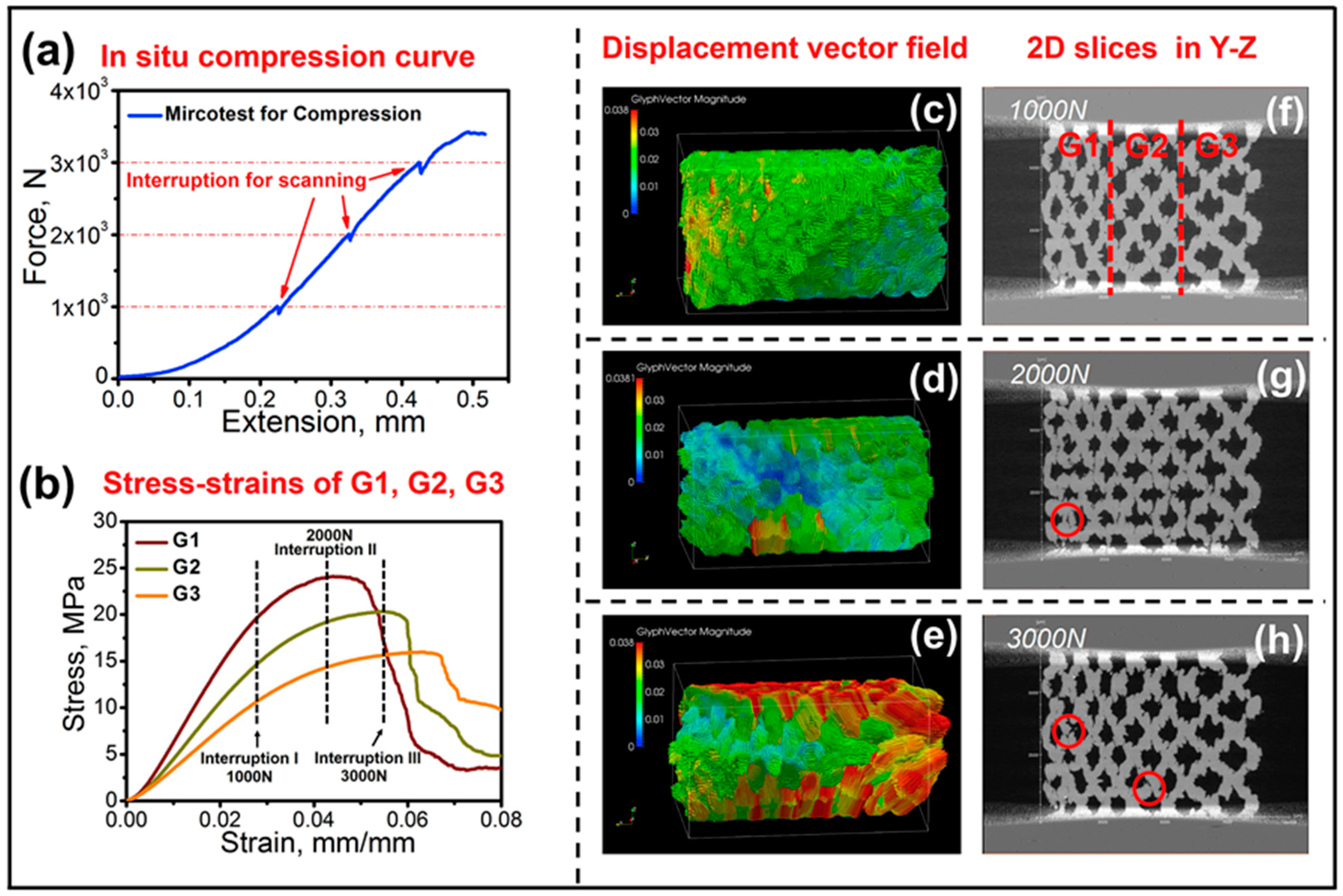
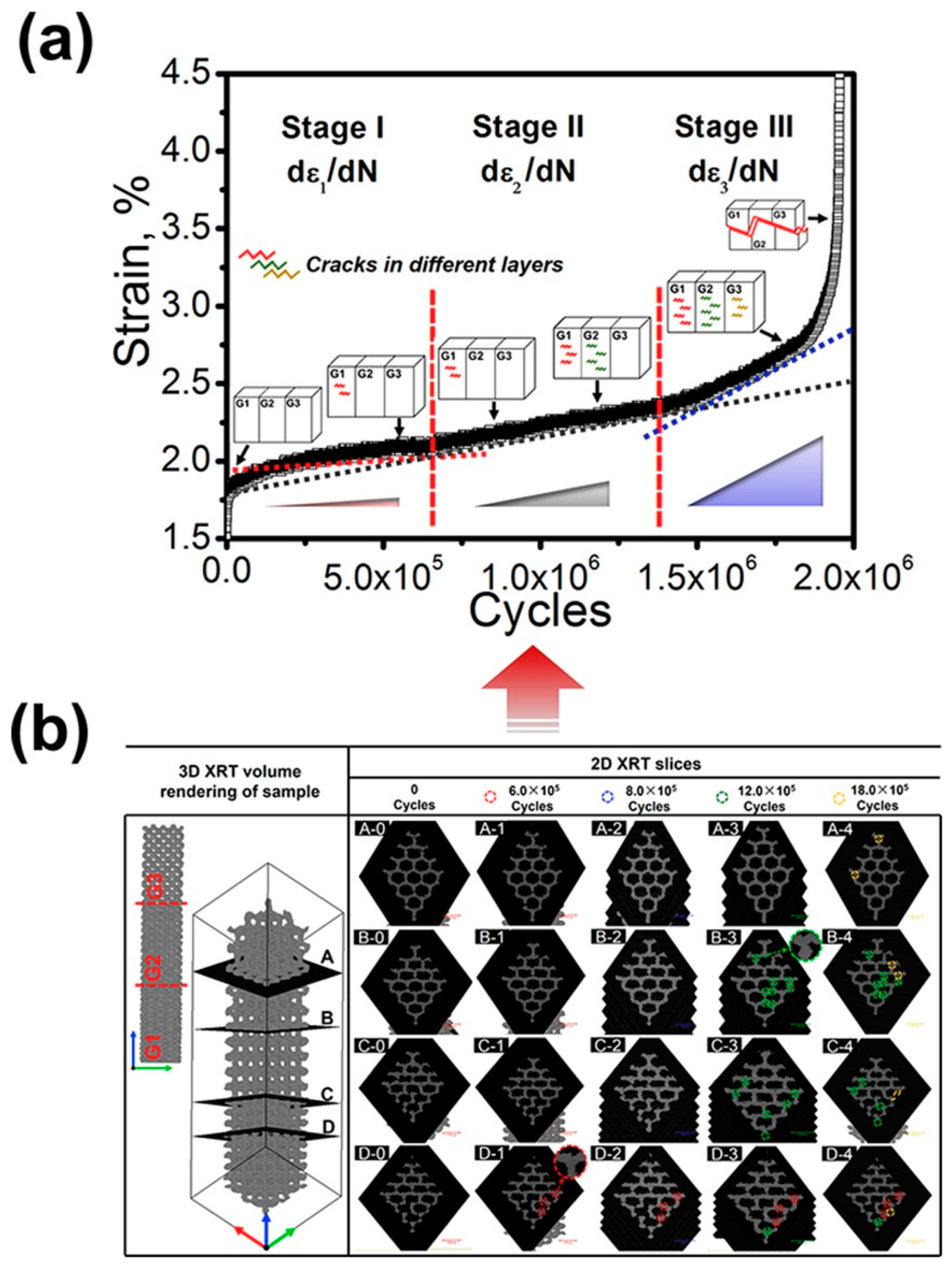
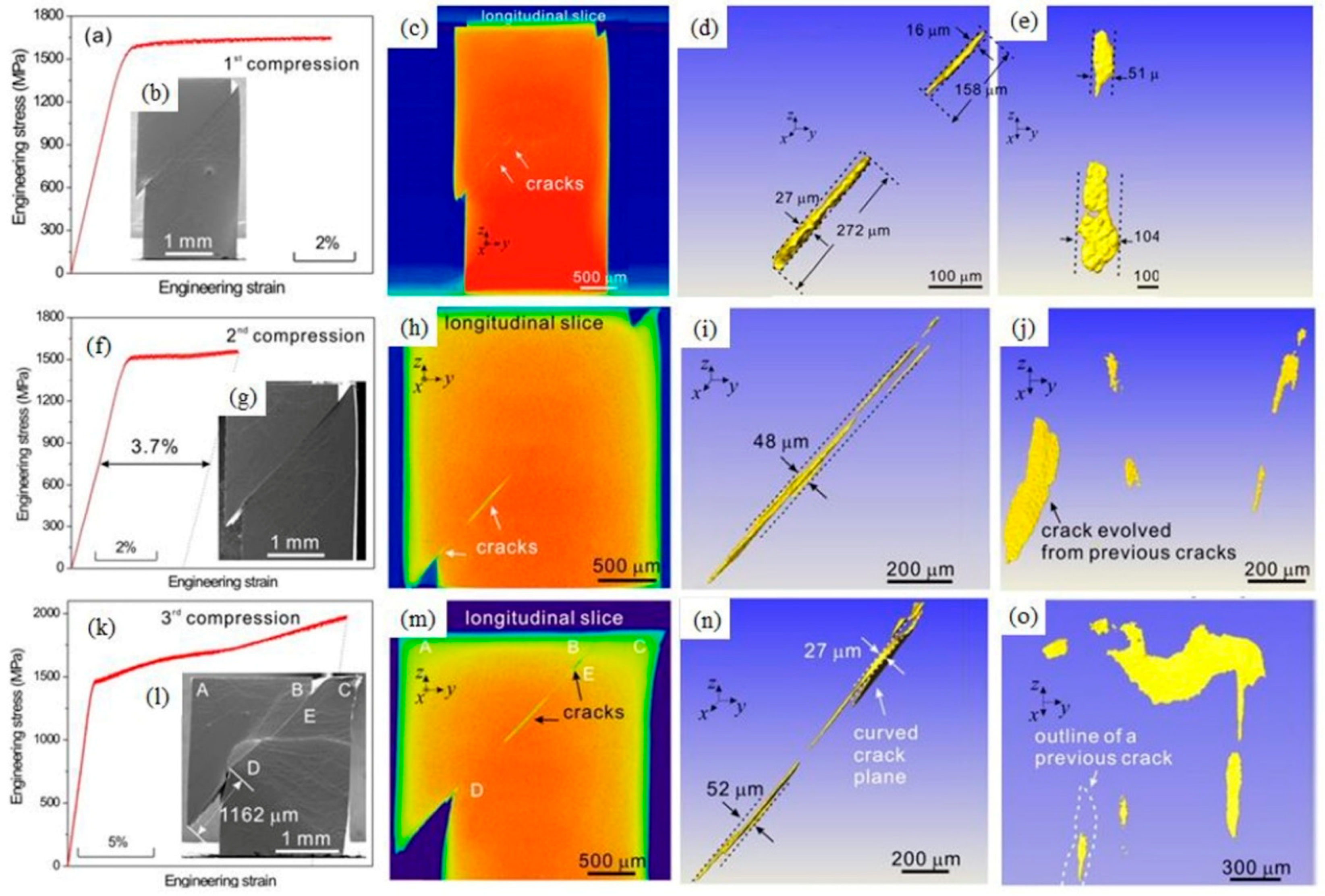
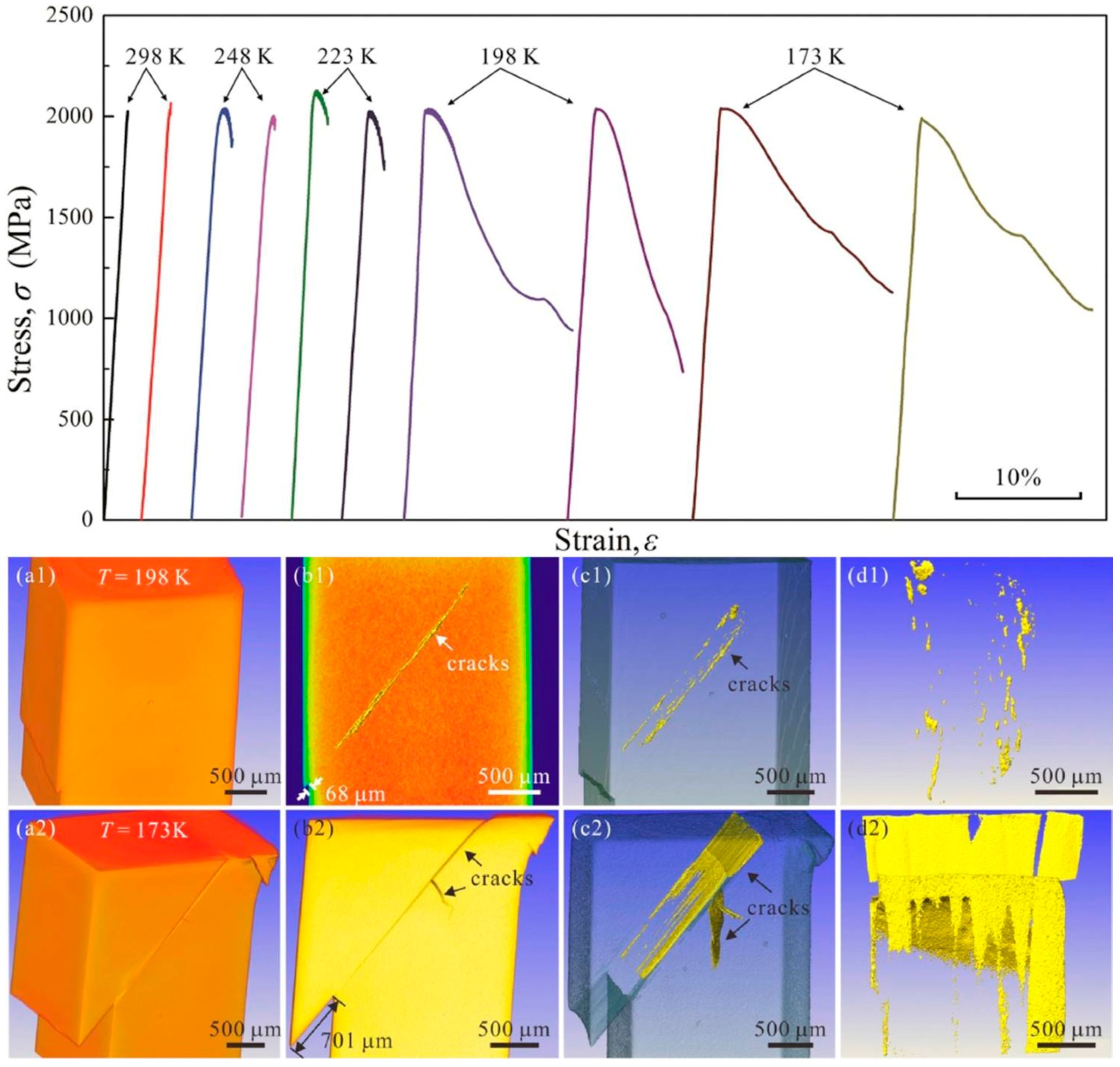
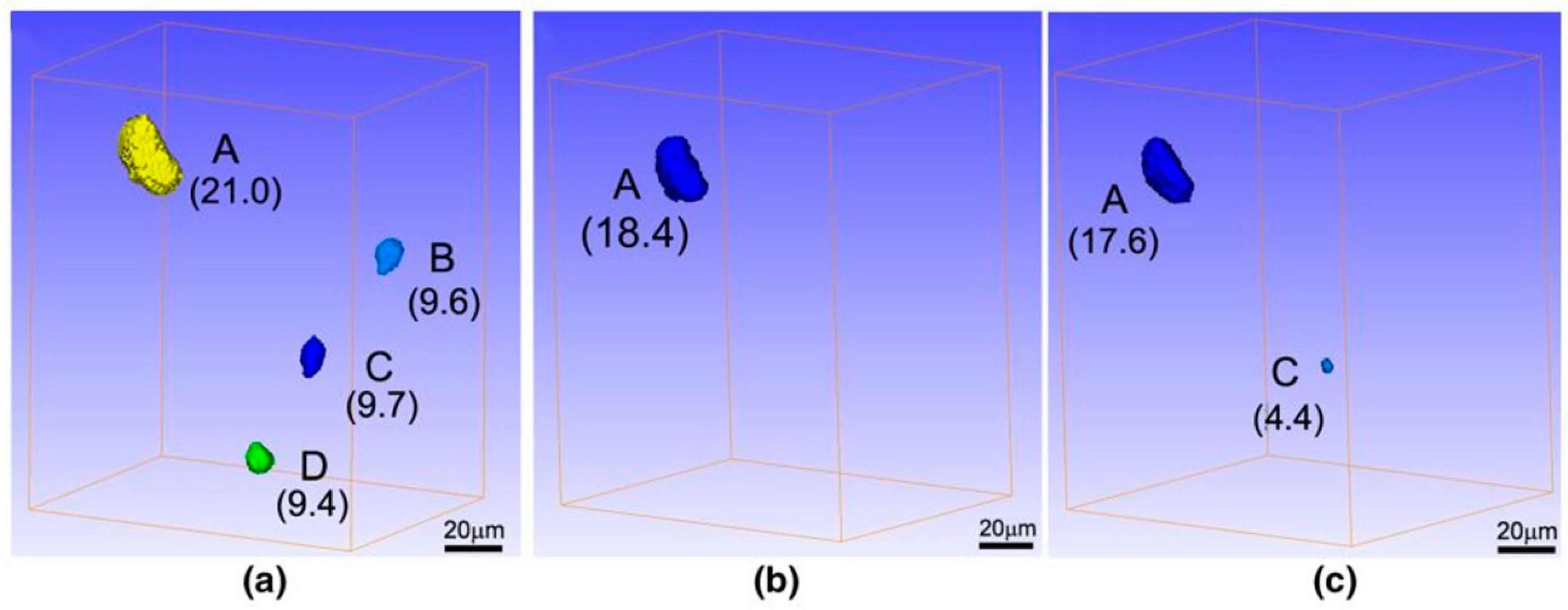
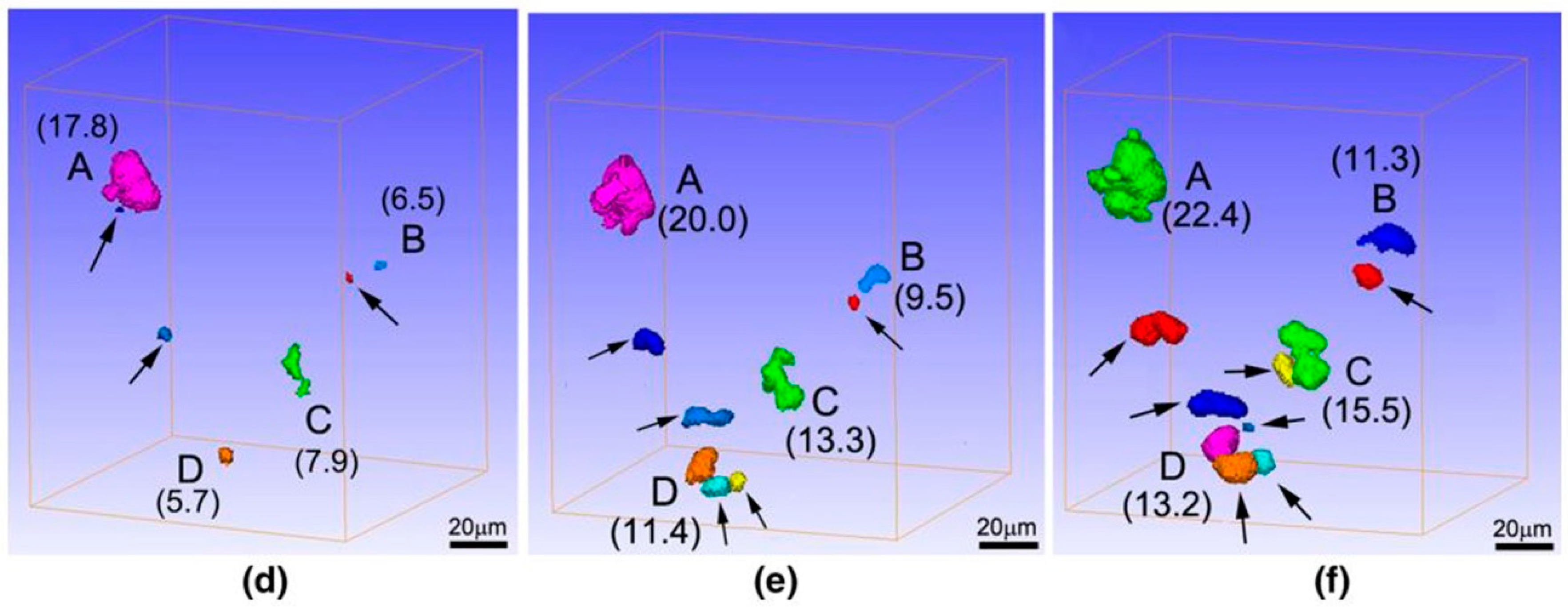

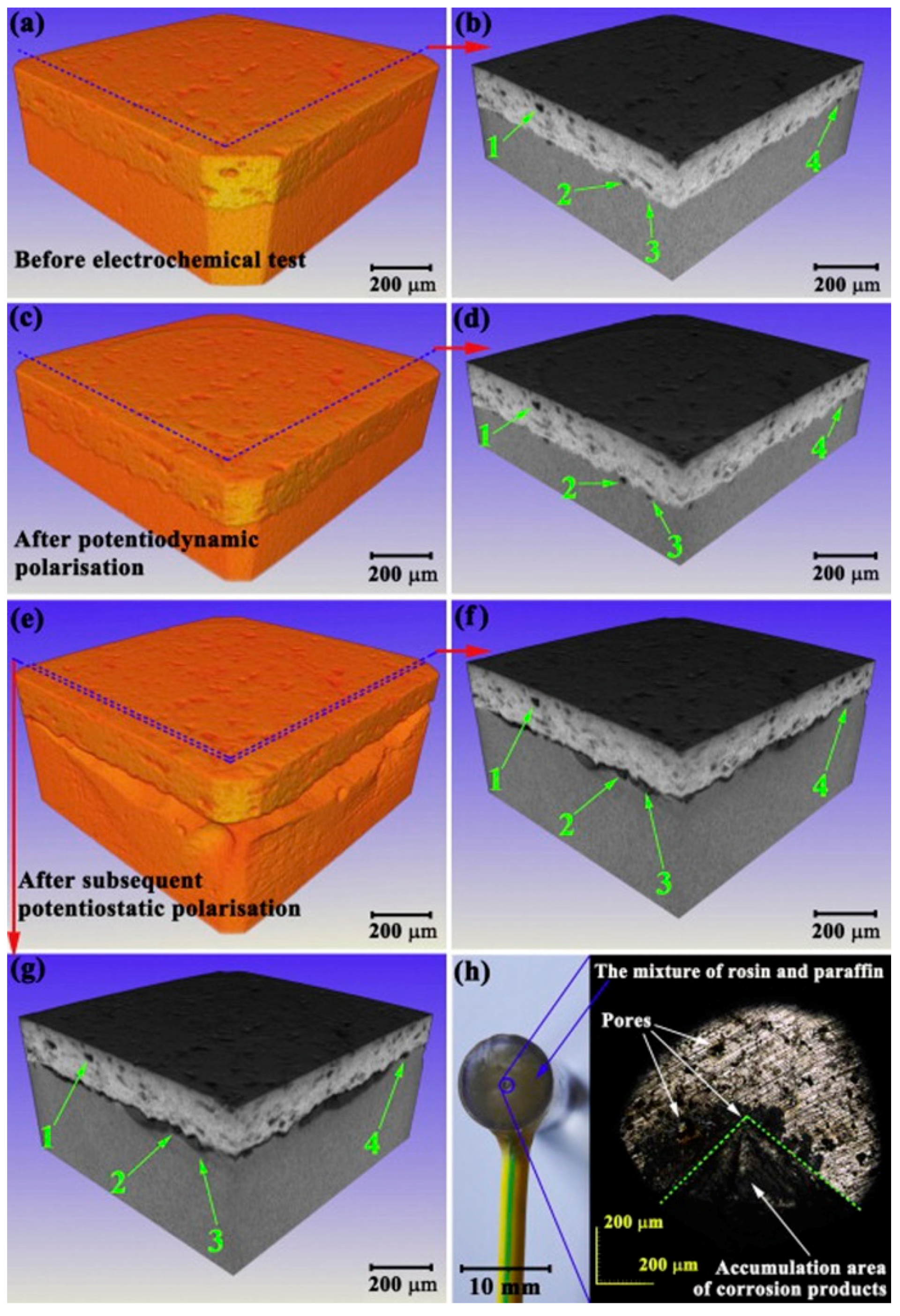

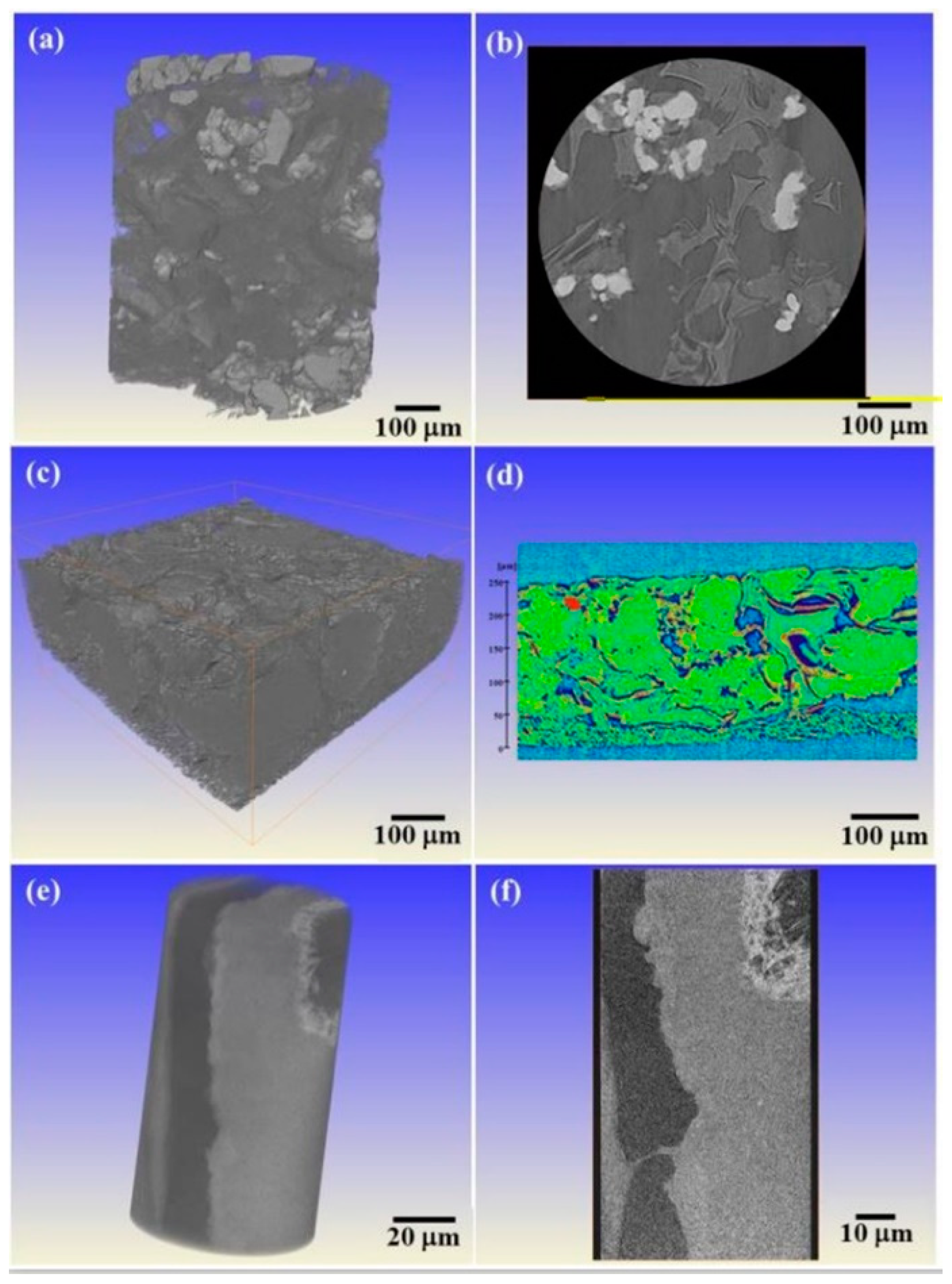
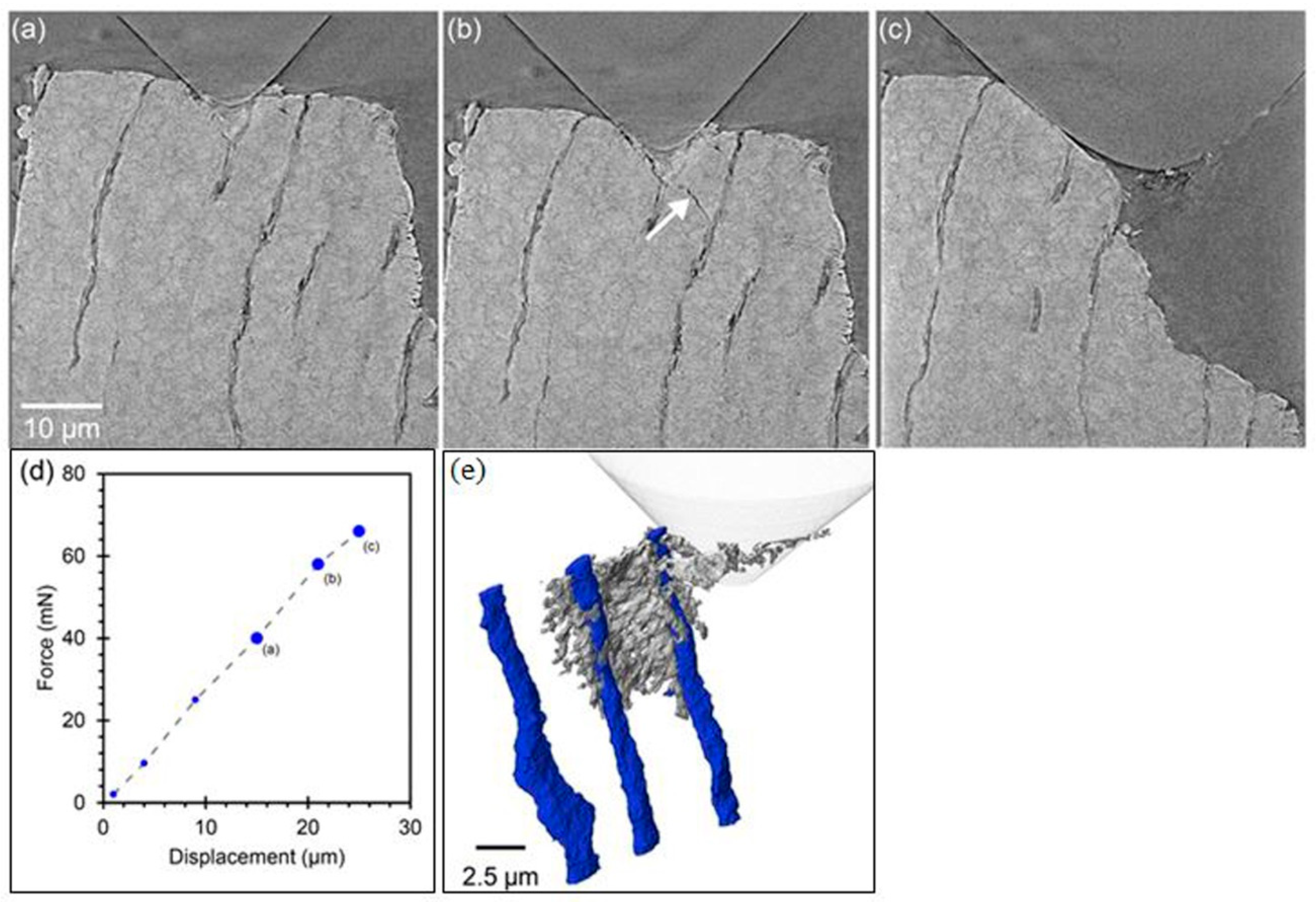
| Source | Facility | Beamline/Model | Energy keV | Flux phs/s | Res. nm | Ref. | XRT |
|---|---|---|---|---|---|---|---|
| SR | ESRF | ID11 | 18–140 | ~ 1014 | 100 | [89] | Monochromatic/Pink Tunable energy Minutes Tomo. Time-lapse Tomo. Absorption contrast Phase contrast |
| APS | 34 ID-C | 5–15 | 5 × 109 | 100 | [90] | ||
| Spring-8 | BL29XUL | 4.4–37.8 | 6 × 1013 | 50 | [91] | ||
| SSRF | B13W1 | 8–72.5 | 3 × 1010 | 100 | [92] | ||
| LB * | MXIF | Gatan XuM | 9.7 | 200 | Web. | Polychromatic/Monochromatic Hours Tomo. Interrupted Tomo. Absorption contrast Phase contrast | |
| IMR | Xradia Versa 500 | 30–160 | 5 × 108 | 700 | Spec. | ||
| IMR | Xradia 810 Ultra | 8 | 50 | Spec. |
© 2018 by the authors. Licensee MDPI, Basel, Switzerland. This article is an open access article distributed under the terms and conditions of the Creative Commons Attribution (CC BY) license (http://creativecommons.org/licenses/by/4.0/).
Share and Cite
Zhang, L.; Wang, S. Correlation of Materials Property and Performance with Internal Structures Evolvement Revealed by Laboratory X-ray Tomography. Materials 2018, 11, 1795. https://doi.org/10.3390/ma11101795
Zhang L, Wang S. Correlation of Materials Property and Performance with Internal Structures Evolvement Revealed by Laboratory X-ray Tomography. Materials. 2018; 11(10):1795. https://doi.org/10.3390/ma11101795
Chicago/Turabian StyleZhang, Lei, and Shaogang Wang. 2018. "Correlation of Materials Property and Performance with Internal Structures Evolvement Revealed by Laboratory X-ray Tomography" Materials 11, no. 10: 1795. https://doi.org/10.3390/ma11101795
APA StyleZhang, L., & Wang, S. (2018). Correlation of Materials Property and Performance with Internal Structures Evolvement Revealed by Laboratory X-ray Tomography. Materials, 11(10), 1795. https://doi.org/10.3390/ma11101795





